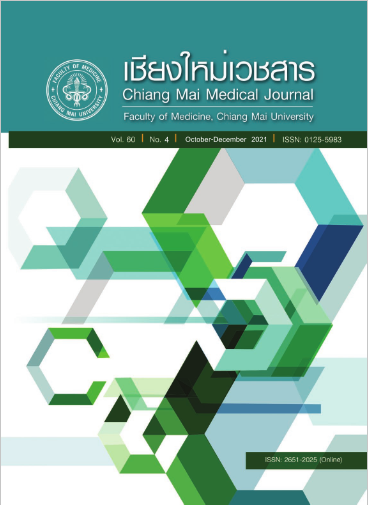Utilization of embedded smartphone application for testing balance in adult to elderly: the study of concurrent validity
Keywords:
balance, force plate, postural control, smartphone, applicationAbstract
Objectives Postural control is an essential component to maintain equilibrium and control individual mobility. Currently, quantitative measures of balance included the force plate analysis systems of center of pressure displacement. Despite, it has been accepted as the gold standard and demonstrated high sensitivity, they still have several limitations. It needs to conduct in laboratory setting and costly. Smartphone technology with embedded sensors may provide a promising evaluation of balance control when force plates are unavailable. The objective of this study was to explore the concurrent validity of the parameters calculated from the smartphone application compared to the force plate-based measure of postural sway.
Methods Fifty-three healthy volunteers, aged 20-72 years were evaluated the ability to control balance during quiet standing. Six static balance tests were conducted in the following order: standing, tandem stance and single leg standing. All tests performed each condition 30 seconds starting from eyes opened then closed.
Results All the sway measurement from smartphone were significantly correlated with the force plate parameter. Data across six balance tasks showed strong positive correlation, the Spearman’s rho correlation coefficients were 0.841-0.866 (p < 0.001).
Conclusion Smartphone parameters demonstrates a high concurrent validity against the gold standard measurement, provided the opportunity for further development in clinical setting. Further studies are needed to determine the reliability and sensitivity to other population.
References
Horak FB. Postural orientation and equilibrium: what do we need to know about neural control of balance to prevent falls? Age Ageing. 2006;35(Suppl 2):ii7–11.
Pollock AS, Durward BR, Rowe PJ, Paul JP. What is balance? Clin Rehabil. 2000;14:402-6.
Mancini M, Horak FB. The relevance of clinical balance assessment tools to differentiate balance deficits. Eur J Phys Rehabil Med. 2010;46:239-48.
Pasma J, Engelhart D, Schouten A, Kooij H, Maier A, Meskers C. Impaired standing balance: The clinical need for closing the loop. Neuroscience. 2014;267:157-65
Prieto TE, Myklebust JB, Hoffmann RG, Lovett EG, Myklebust BM. Measures of postural steadiness: differences between healthy young and elderly adults. IEEE Trans Biomed Eng. 1996;43:956-66.
Seimetz C, Tan D, Katayama R, Lockhart T. A comparison between method of measuring postural stability: force plates versus accelerometers. Biomed Sci Instrum. 2012;48:386-92.
Moral-Munoz JA, Esteban-Moreno B, Herrera-Viedma E, Cobo MJ, Pérez IJ. Smartphone applications to perform body balance assessment: a standardized review. J Med Syst. 2018;42:119.
Hou Y-R, Chiu Y-L, Chiang S-L, Chen H-Y, Sung W-H. Development of a smartphone-based balance assessment system for subjects with stroke. Sensors. 2019;20:88.
Balasubramanian CK, Boyette A, Wludyka P. How Well Do functional assessments of mobility and balance discriminate fallers and recurrent fallers from non-fallers among ambulatory older adults in the community? Physiother Can. 2015;67:184-93.
Roeing KL, Hsieh KL, Sosnoff JJ. A systematic review of balance and fall risk assessments with mobile phone technology. Arch Gerontol Geriatr. 2017;73:222-6.
Neville C, Ludlow C, Rieger B. Measuring postural stability with an inertial sensor: validity and sensitivity. Med Devices Auckl NZ. 2015; 8:447-55.
Mancini M, Salarian A, Carlson-Kuhta P, Zampieri C, King L, Chiari L, et al. ISway: a sensitive, valid and reliable measure of postural control. J Neuroeng Rehabil. 2012;9:59.
Piirtola M, Era P. Force platform measurements as predictors of falls among older people–a review. Gerontology. 2006;52:1-16.
Karlsson A, Frykberg G. Correlations between force plate measures for assessment of balance. Clin Biomech. 2000;15:365-9.
Liu J, Tang W, Chen G, Lu Y, Feng C, Tu XM. Correlation and agreement: overview and clarification of competing concepts and measures. Shanghai Arch Psychiatry. 2016;28:115-20.
Martinez-Mendez R, Sekine M, Tamura T. Postural sway parameters using a triaxial accelerometer: comparing elderly and young healthy adults. Comput Methods Biomech Biomed Engin. 2012;15:899-910.
Hubble RP, Naughton GA, Silburn PA, Cole MH. Wearable sensor use for assessing standing balance and walking stability in people with Parkinson’s disease: a systematic review. PLoS ONE. 2015;10:e0123705.
Heebner NR, Akins JS, Lephart SM, Sell TC. Reliability and validity of an accelerometry based measure of static and dynamic postural stability in healthy and active individuals. Gait Posture. 2015;41:535-9.
Mancini M, Horak FB, Zampieri C, Carlson-Kuhta P, Nutt JG, Chiari L. Trunk accelerometry reveals postural instability in untreated Parkinson’s disease. Parkinsonism Relat Disord. 2011;17:557-62.
Kosse NM, Caljouw S, Vervoort D, Vuillerme N, Lamoth CJC. Validity and reliability of gait and postural control analysis using the tri-axial accelerometer of the ipod touch. Ann Biomed Eng. 2015;43:1935-46.
Hsieh KL, Roach KL, Wajda DA, Sosnoff JJ. Smartphone technology can measure postural stability and discriminate fall risk in older adults. Gait Posture. 2019;67:160-5.
Reyes A, Qin P, Brown CA. A standardized review of smartphone applications to promote balance for older adults. Disabil Rehabil. 2018; 40:690–6.
Downloads
Published
How to Cite
Issue
Section
License

This work is licensed under a Creative Commons Attribution-NonCommercial-NoDerivatives 4.0 International License.










